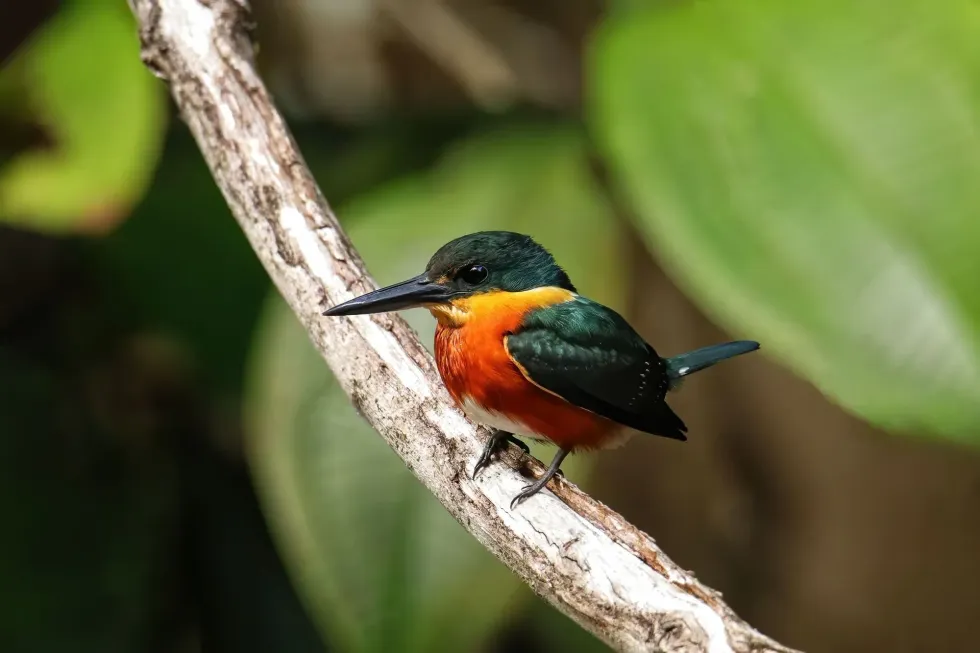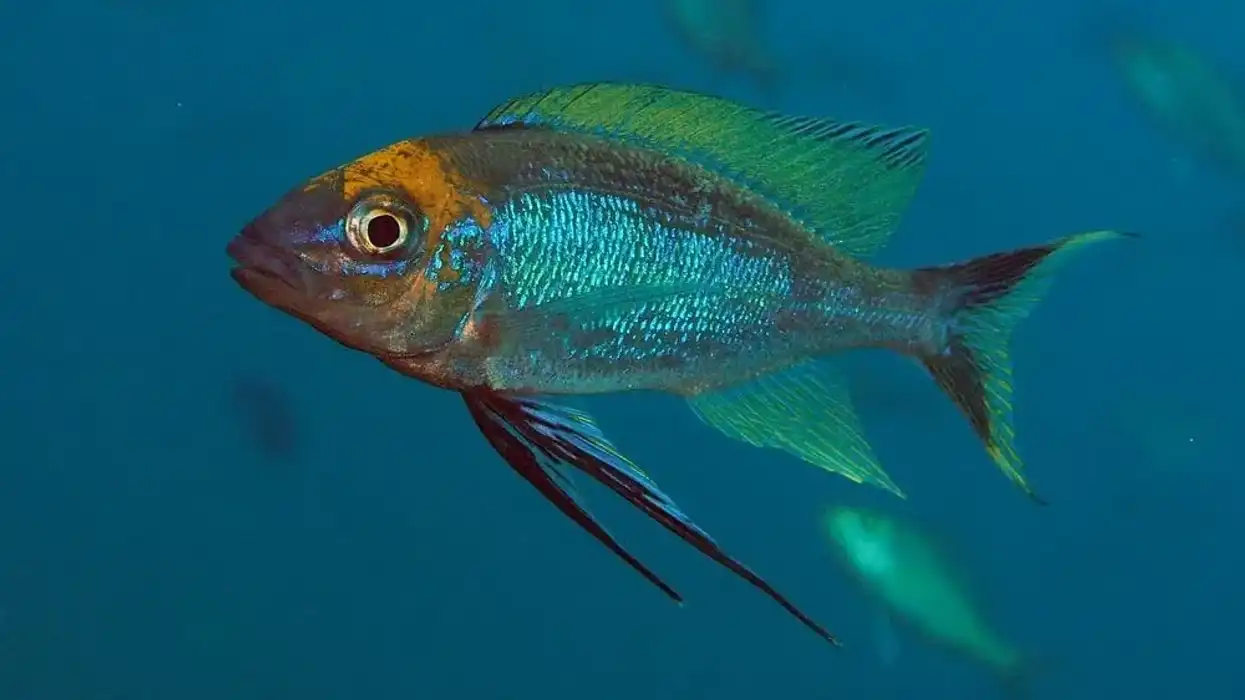The American Pygmy Kingfisher (Chloroceryle aenea) is a bird species under the family Alcedinidae, native to tropical South America. This bird is found across southern Mexico, Costa Rica, central Brazil, Argentina, Paraguay, Guatemala, and Peru. This bird species inhabits densely vegetated river banks, forests, and mangrove swamps.
This bird has a characteristic color pattern with rufous underparts, orange-yellow neck, and grimy-green head and back. They also have a white belly patch, a short tail, and a strong, long beak.
This bird species is a carnivore and eats tadpoles, small fish, and even insects through hawking. Although this species is not very shy, they are usually seen perched silently on branches and their calls also resemble a soft 'tik' or 'cht-cht.'
During each breeding season, the American Pygmy Kingfisher (Chloroceryle aenea) lays three to four white eggs. They build tunnel-like 15.7 in (40 cm) long nests close to the riverbank so that food is easily accessible. In addition, their numbers are decreasing, but the IUCN has declared the status of Least Concern for this species.
If you enjoy reading about different bird species, check out the Giant Cowbird and the Cambodian Tailorbird.
American Pygmy Kingfisher Interesting Facts
What type of animal is an American Pygmy Kingfisher?
The American Pygmy Kingfisher (Chloroceryle aenea) is a bird species native to the tropics of South America.
What class of animal does the American Pygmy Kingfisher belong to?
This bird belongs to the class of Aves under the order of Coraciiformes, family Alcedinidae and genus Chloroceryle.
How many American Pygmy Kingfishers are there in the world?
Even though their population is decreasing, they have a global population of 500,000-4,999,999 mature individuals.
Where does the American Pygmy Kingfisher live?
This bird species is found across the North American Tropics and occurs in Bolivia, central Brazil, Costa Rica, Argentina, Guatemala, Colombia, Guyana, Trinidad and Tobago, Panama, Venezuela, Peru, El Salvador, southern Mexico, and Paraguay.
What is an American Pygmy Kingfisher habitat?
The American Pygmy Kingfisher (Chloroceryle aenea) lives in tropical and subtropical forests, mangrove swamps, peatlands, and on the banks of lakes, rivers, or streams. Usually, they live in places with dense vegetation.
Who does the Amazon Umbrellabird live with?
The exact living behavior of this bird species is unknown. However, kingfishers are known to be solitary with a territory range of around 3.1 mi (5 km) and only pair up during the breeding season.
How long does an American Pygmy Kingfisher live?
The lifespan of the American Pygmy Kingfisher (Chloroceryle aenea) is unknown, but generally, kingfishers are known to live for around 15 years.
How do they reproduce?
The American Pygmy Kingfisher (Chloroceryle aenea) can have several broods in a year and both parents care for the young. These birds build nests which are 15.7 in (40 cm) long tunnels on a riverbank so that food is easily accessible.
The nest is placed horizontally, and sometimes, this bird uses arboreal termite nests or earth heaps. The female kingfishers of this species lay three to four white eggs. The male protects the nesting territory and the female incubates the eggs for around 21 days.
After hatching, the chicks leave the nest when they are around two months old. Until then, the parents feed and care for them.
What is their conservation status?
Despite their decreasing population, the American Pygmy Kingfisher (Chloroceryle aenea) has been given the conservation status of Least Concern.
American Pygmy Kingfisher Fun Facts
What does the American Pygmy Kingfisher look like?
The American Pygmy Kingfisher (Chloroceryle aenea) is quite colorful with its unique rufous, yellow, green, and black display. The Kingfisher has an oily green head, back, and wings.
They have a blackish tinge on the tips of their wings as well. The birds have a white belly patch with an orange-yellow ring around their throat, rufous underparts, with a body at 5.1 in (13 cm) long and weigh 0.35-0.56 oz (10-16 g).
These birds show some level of sexual dimorphism because the female has a thin, green breast band, which is absent in the males. The young ones have light-spotted wings and flanks, with the same overall color but absent breast band.
 *We've been unable to source an image of an American Pygmy Kingfisher and have used an image of a common Kingfisher instead. If you are able to provide us with a royalty-free image of the American Pygmy Kingfisher, we would be happy to credit you. Please contact us at hello@kidadl.com.
*We've been unable to source an image of an American Pygmy Kingfisher and have used an image of a common Kingfisher instead. If you are able to provide us with a royalty-free image of the American Pygmy Kingfisher, we would be happy to credit you. Please contact us at hello@kidadl.com.
How cute are they?
Since this American Pygmy Kingfisher (Chloroceryle aenea) is a small bird with a comparatively long beak, it looks quite cartoonish and cute.
How do they communicate?
Although there is no accurate information about their communication, the American Pygmy Kingfisher call is a quiet, short chirp, usually a soft 'tik' or 'cht-cht.' And sometimes, a song of high, fast notes.
How big is the American Pygmy Kingfisher?
The American Pygmy Kingfisher size is measured at 5.1 in (13 cm), which is around half the size of the Mockingbird.
How fast can an American Pygmy Kingfisher fly?
There is no record of how fast this bird species can fly. However, based on several observations, it is known that these birds have a quick, buzz-like flight.
How much does an American Pygmy Kingfisher weigh?
This bird species is quite tiny and weighs around 0.35-0.56 oz (10-16 g), which is around the same weight as the Gouldian Finch.
What are the male and female names of the species?
The male and female of this species do not have separate names, but there is a difference between the subspecies. The subspecies found around southern Mexico to central Costa Rica are C. a. stictoptera (Ridgway, 1884). The ones found from central Costa Rica to Bolivia, Argentina, Paraguay, and central-southern Brazil are C. a. aenea (Pallas, 1764).
What would you call a baby American Pygmy Kingfisher?
The babies of this species (Chloroceryle aenea) can be called a chick or juvenile, similar to most of the other birds.
What do they eat?
The American Pygmy Kingfisher diet is mainly carnivorous and includes fish and insects such as lake trouts, larvae, water beetles, or cockroaches. These birds observe water surfaces from tree branches and dive not more than 10 in (25.4 cm) deep to capture the prey.
They are also highly territorial and choose areas near river banks for easily accessible food supply. In addition, these birds must make sure that they constantly consume more than 60 % of their total body weight, resulting in them getting into fights with other kingfishers.
Are they dangerous?
No, these birds are quite small and are not dangerous to humans or other animals. However, they are known to be highly territorial and will get into fights over food with other kingfishers.
Would they make a good pet?
Not exactly. These birds are wild and live in dense forests. Therefore, keeping them in captivity will not only be inconvenient but will also take them away from their natural habitat.
Did you know...
Kingfishers are famously known for their ability to catch fish and bright plumage.
Although some of the species are threatened, kingfishers are one of the most common birds in the tropics.
The two subspecies have minor differences, i.e., the C. a. aenea has two white-spotted lines on its wings while the C. a. stictoptera has three to four white-spotted lines and a white patch on its tail.
How many types of Kingfishers are there?
There are around 114 species of kingfishers under the family of Alcedinidae, categorized under three subfamilies, and 19 genera, all under the order of Coraciiformes. Most of their population occurs across the tropics of Asia, Oceania, and Africa. These birds have characteristic features such as their round bodies, thick heads, and heavy bills.
Are American Pygmy Kingfishers endemic species?
Yes, this species is endemic to the tropical regions of South American. It is a resident breeder and occurs in Mexico, Costa Rica, Brazil, Argentina, Paraguay, Bolivia, Ecuador, and Trinidad.
Here at Kidadl, we have carefully created lots of interesting family-friendly animal facts for everyone to discover! Learn more about some other birds from our Common Kingfisher facts and Belted Kingfisher facts pages.
You can even occupy yourself at home by coloring in one of our free printable American Pygmy Kingfisher coloring pages.




 *We've been unable to source an image of an American Pygmy Kingfisher and have used an image of a common Kingfisher instead. If you are able to provide us with a royalty-free image of the American Pygmy Kingfisher, we would be happy to credit you. Please contact us at hello@kidadl.com.
*We've been unable to source an image of an American Pygmy Kingfisher and have used an image of a common Kingfisher instead. If you are able to provide us with a royalty-free image of the American Pygmy Kingfisher, we would be happy to credit you. Please contact us at hello@kidadl.com.



